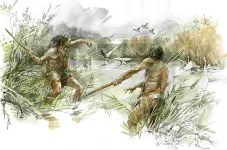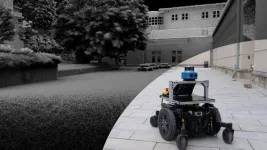(Press-News.org)
A 300,000-year-old hunting weapon has shone a new light on early humans as woodworking masters, according to a new study.
State-of-the-art analysis of a double-pointed wooden throwing stick, found in Schöningen in Germany three decades ago, shows it was scraped, seasoned and sanded before being used to kill animals. The research indicates early humans’ woodworking techniques were more developed and sophisticated than previously understood.
The findings, published today (Wednesday, 19 July) in PLOS ONE, also suggest the creation of lightweight weapons may have enabled group hunts of medium and small animals. The use of throwing sticks as hunting aids could have involved the entire community, including children.
Dr Annemieke Milks, of the University of Reading’s Department of Archaeology, led the research. She said: “Discoveries of wooden tools have revolutionised our understanding of early human behaviours. Amazingly these early humans demonstrated an ability to plan well in advance, a strong knowledge of the properties of wood, and many sophisticated woodworking skills that we still use today.
“These lightweight throwing sticks may have been easier to launch than heavier spears, indicating the potential for the whole community to take part. Such tools could have been used by children while learning to throw and hunt.”
Co-author Dirk Leder said: “The Schöningen humans used a spruce branch to make this aerodynamic and ergonomic tool. The woodworking involved multiple steps including cutting and stripping off the bark, carving it into an aerodynamic shape, scraping away more of the surface, seasoning the wood to avoid cracking and warping, and sanding it for easier handling.”
High-impact weapon
Found in 1994, the 77cm-long stick is one of several different tools discovered in Schöningen, which includes throwing spears, thrusting spears and a second similarly sized throwing stick.
The double-pointed throwing stick – analysed to an exceptionally high level of detail for this new study - was most likely used by early humans to hunt medium-sized game like red and roe deer, and possibly fast-small prey including hare and birds that were otherwise difficult to catch. The throwing sticks would have been thrown rotationally – similar to a boomerang - rather than overhead like a modern-day javelin and may have enabled early humans to throw as far as 30 metres. Although lightweight, the high velocities at which such weapons can be launched could have resulted in deadly high-energy impacts.
The fine surface, carefully shaped points and polish from handling suggest this was a piece of personal kit with repeated use, rather than a quickly made tool that was carelessly discarded.
Principal investigator Thomas Terberger said: “The systematic analysis of the wooden finds of the Schöningen site financed by German Research Foundation provides valuable new insights and further exciting information on these early wooden weapons can be expected soon.”
The well-preserved stick is on display at the Forschungsmuseum in Schöningen.
END
· Contacts between lysosomes and mitochondria are broken due to Parkinson’s mutation
· Lysosomes cannot ‘feed’ mitochondria with essential metabolites
CHICAGO --- Northwestern Medicine scientists have uncovered a new mechanism by which mutations in a gene parkin contribute to familial forms of Parkinson's disease. The discovery opens a new avenue for Parkinson’s therapeutics, scientists report in a new study.
The Northwestern scientists discovered that mutations in parkin result in a breakdown ...
A research group in Carnegie Mellon University's Robotics Institute is creating the next generation of explorers — robots.
The Autonomous Exploration Research Team has developed a suite of robotic systems and planners enabling robots to explore more quickly, probe the darkest corners of unknown environments, and create more accurate and detailed maps. The systems allow robots to do all this autonomously, finding their way and creating a map without human intervention.
"You can set it in any environment, like a department store or a residential building after a disaster, and off it goes," ...
What determines whether we become overweight? Aside from lifestyle, predisposition plays a role, but genes cannot fully explain the inherited propensity to accumulate excess weight. A new study by Charité – Universitätsmedizin Berlin in Science Translational Medicine* shows that a kind of formatting of the DNA code in one gene that is associated with satiety is implicated in a slightly elevated risk of excess body weight – at least in women. This “epigenetic marking” is established early on during the embryonic stage.
People who are overweight, especially those who ...
“Don’t eat me!” That’s how one might translate the signal that the cancer cells in a glioblastoma send to the macrophages (white blood cells specialized in removing dead and dying cellular matter) in the brain. Immunotherapy attempts to enable these cells to eradicate the abnormal cells, but so far, it has met with little success when it comes to glioblastomas.
Researchers led by Professor Gregor Hutter from the Department of Biomedicine at the University and University Hospital Basel have recently used patient data, experiments with mice, and samples from human tumors to study one of these “don’t eat me!” signals and its inhibitory ...
The research, funded by the British Heart Foundation and published in the journal Circulation, opens the prospect of treating the condition at the earliest stages.
Being able to detect HCM earlier than ever before will also assist trials investigating gene therapies and drug treatments aimed at stopping the disease developing in those at risk.
HCM is an inherited condition that affects around 1 in 500 people in the UK. It causes the muscular walls of the heart to become thicker than normal, affecting how well the heart can pump blood around the body. It is ...
When it comes to disaster response and recovery operations, it is crucial that workers are prepared before there is an emergency, according to Rutgers researchers.
Their study, published in New Solutions: A Journal of Environmental and Occupational Health Policy, outlines the importance of the Worker Training Program to United States emergency and disaster-response infrastructure.
"It is essential to identify and deliver core disaster training to responders and workers on a routine basis prior to an [emergency] event," said Mitchel Rosen, an associate professor at the Rutgers School of Public Health. “The failure ...
HOUSTON ― The University of Texas MD Anderson Cancer Center’s Research Highlights showcases the latest breakthroughs in cancer care, research and prevention. These advances are made possible through seamless collaboration between MD Anderson’s world-leading clinicians and scientists, bringing discoveries from the lab to the clinic and back.
Recent developments include promising results from combining immunotherapy with radiation for non-small cell lung cancer (NSCLC), a novel combination therapy for secondary and treatment-resistant ...
A good battery needs two things: high energy density to power devices, and stability, so it can be safely and reliably recharged thousands of times. For the past three decades, lithium-ion batteries have reigned supreme — proving their performance in smartphones, laptops, and electric vehicles.
But battery researchers have begun to approach the limits of lithium-ion. As next-generation long-range vehicles and electric aircraft start to arrive on the market, the search for safer, cheaper, and more powerful ...
The longest nerve in the human body starts in the brain and meanders its way down the neck and into the chest, where it splits into separate branches, winding its twisting tendrils to touch each internal organ. Known as the “information superhighway” and aptly named from the Latin word meaning “wanders,” the vagus nerve is a bundle of fibers responsible for the parasympathetic nervous system: digestion, heart rate, breathing.
Sending electrical impulses down this tenth cranial nerve has proven effective in treating conditions like depression and epilepsy, ...
The formation of the country’s first emergency department for the over 80s led to a significant decrease in time spent in A&E – according to research from the Norfolk and Norwich University Hospital (NNUH) and University of East Anglia (UEA).
The first Older People’s Emergency Department in England was opened at NNUH in December 2017 to bring specialists in older people’s medicine to the front doors of the hospital and provide earlier assessment and treatment for patients.
A new study evaluates the outcomes for patients who received treatment in the main emergency department at NNUH and a similar ...






